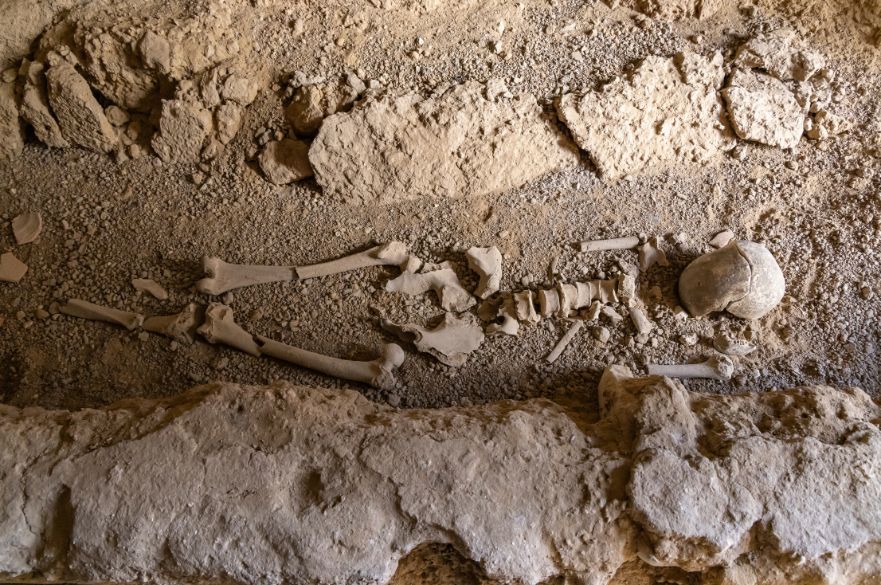Expert Blog: Bones on the bus - how should we treat ancient human remains?
Associate Professor Helen Hall, Nottingham Law School, explores the legal and ethical dilemmas of how we treat ancient human remains in modern society.
By Associate Professor Helen Hall | Published on 14 May 2025
Categories: Press office; Research; Nottingham Law School;

The Human Tissue Act 2004 regulates the treatment of human bodies after death, but it has a one hundred year cut-off point: remains more than a century old are in most circumstances beyond its remit. Parliament did consider this watershed when debating the legislation. In the House of Lords, one peer in particular expressed concern at the thought of archaeologists hopping onto London buses clutching carrier bags containing human bones. The appropriate treatment of human remains raises various questions for those who make and apply the law, but also for wider society.
There are good reasons why we exercise special care in relation to the remains of the recently departed - individuals whose wishes are often clearly known, and who are still remembered by living friends and family members. Failure to do this can have devastating consequences. For example, when the mountaineer George Mallory was located on Mount Everest in 1999, around 75 years after his death, photographs of his semi-naked body were flashed around the world’s TV screens and internet. His daughter, Clare Mallory Millikan, was not even warned in advance and certainly did not give permission. She had been eight years old at the time of his death and remembered her father very well. One of the team who found Mallory described it as like discovering a Spanish galleon. The contrast is stark, one person’s treasure and material gain were another’s beloved daddy.
What do we owe the long-dead? Respect, culture and contested meanings
However, what about the dead who have slipped beyond the threshold of living memory? What do we owe to them? The answer to this in social terms depends very much on culture, and how we understand the human community in relation to the dead and ancestors. This is why it is essential to give special consideration to the remains of indigenous and colonised peoples, taken by force, or at least without true consent. Fortunately, there is increasing awareness of this issue, both in the museum sector and more widely, and international protocols addressing this matter. Yet this leaves us with distinct questions where human remains belong to individuals who died in the British Isles, and were dealt with according to their wishes, and/or the practices of the community surrounding them at the time of their death.
Twenty-first century Britain is a diverse society in respect of culture and belief, but there is an overarching acceptance of the idea that human remains should be treated with respect. Very few people, regardless of worldview or religious affiliation, would suggest that a skeleton or a bog body is simply an object, in the same way as a hoard of coins or a clay jar. Furthermore, the Common Law offence of outraging public decency has long been applied to protect dead bodies from disrespectful treatment. It is possible to imagine this being invoked if human remains were subjected to egregious abuse, at least in public. If such mistreatment was recorded and posted online, it is also possible that offences under the Communications Act 2003 might be invoked.
However, what about cases where there was scope for disagreement about whether the handling of ancient human remains was in fact disrespectful? Although there might be broad consensus that even historical human bodies deserve respect, there is a lot of variation about what respect means in practice.
How should ancient remains be handled?
Some voices equate “respect” with burial, or at the very least, keeping human remains away from the curious gaze of the general population. For some, it is legitimate to allow experts to view human remains for serious academic purposes, but not to let any Tom, Dick or Harriet to peer at them just because they are curious. In contrast, others view this position as elitist and also ascribing the norms and sensibilities of contemporary society onto the ancient dead. Some individuals might prefer to be remembered in some manner, surrounded by the bustle of museum visitors and the chatter of school parties, than locked away alone.
We know from contemporary society that people have very different desires regarding the treatment of their body after death, and this has been true across time and space. For instance, the philosopher Jeremy Bentham wanted his corpse to be preserved and interacted with on a regular basis. He got his wish, and is currently sitting in a glass case in UCL, with staff, students and others constantly passing by.
There may well be good reasons to consider introducing specific legislation to regulate the treatment of ancient human remains, but before we rush to pass a new law, we should pause to think what we are doing and whose needs are being met. We should be cautious about setting in stone a rigid idea of respectful treatment, that fails to allow sufficient flexibility for diverse circumstances, or changing social attitudes. We need to avoid acting in ways that neither our ancestors, nor perhaps our descendants, would necessarily be thankful for.